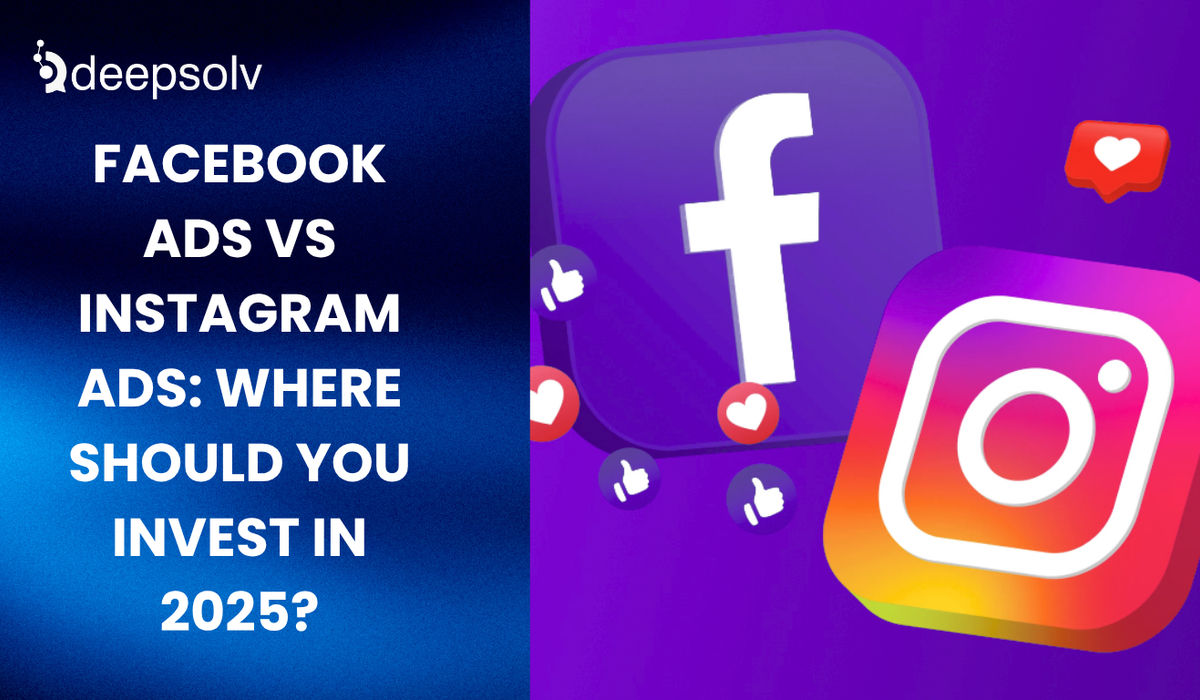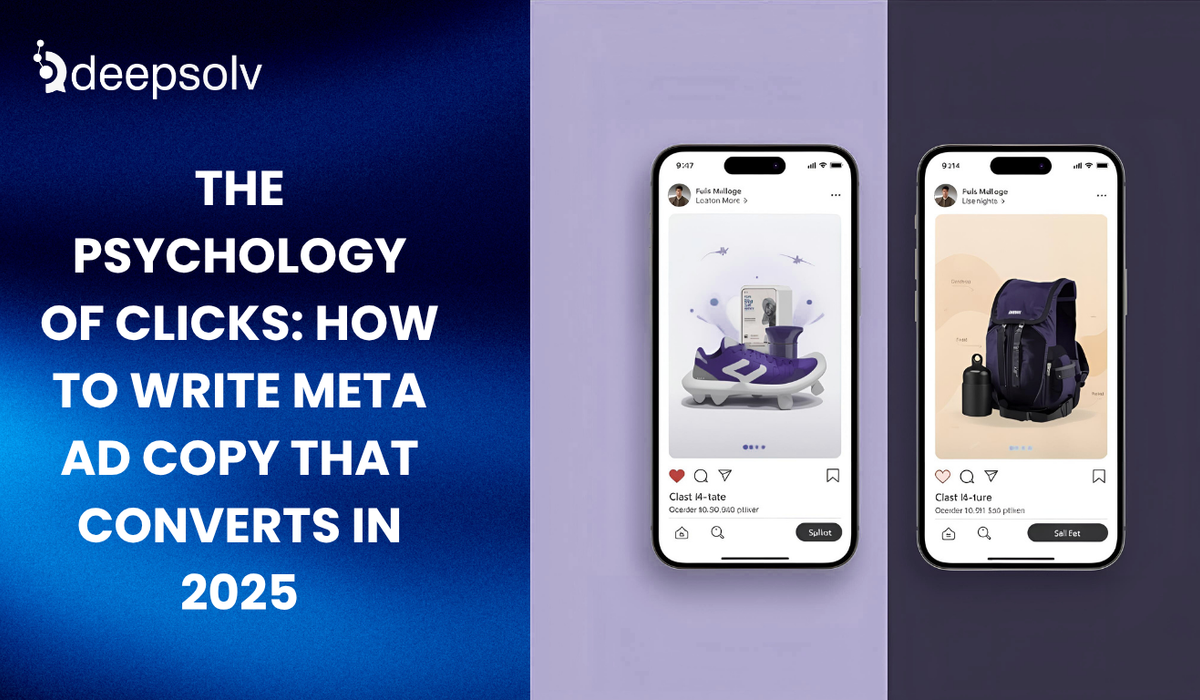Facebook Ads vs Instagram Ads: Where Should You Invest in 2025?
5 min read
Published: 10/5/2025

Introduction: Same Company, Different Worlds
Both Facebook and Instagram live under Meta’s roof, but in 2025, they’ve evolved into two distinct ecosystems.
Facebook remains a data-rich, community-driven platform with deeper discussions, older demographics, and high intent among established audiences. Instagram, meanwhile, thrives on visual storytelling, younger consumers, and trend-led discovery.
So when brands ask,
“Should we put more budget on Facebook or Instagram this year?”
the answer isn’t as simple as picking one. It depends on your product, audience, creative strategy, and funnel goals.
In this guide, we’ll unpack how Facebook and Instagram Ads perform differently in 2025, what’s changed since previous years, real brand examples that show each platform’s strengths, and how to decide where your next rupee (or dollar) belongs.
The 2025 Landscape: What’s Changed
Advertising on Meta isn’t what it used to be. Three big shifts define 2025:
1. AI Has Reshaped Targeting
Meta’s Advantage+ automation suite now dominates ad delivery — automatically optimizing creative, placement, and audiences. While this has improved performance, it’s also blurred the line between Facebook and Instagram targeting.
2. Privacy-First Data Rules
Post-iOS 14 changes have matured into a permanent privacy-centric reality. First-party data and conversion API (CAPI) integration are now mandatory for reliable attribution.
3. Platform Behaviors Have Diverged Even More
Facebook’s engagement skews toward community groups, long-form discussions, and event marketing. Instagram is all about Reels, influencer integration, and lifestyle aspiration.
Translation: both platforms are still powerful but in very different ways.
Audience Deep-Dive: Who’s Where in 2025
| Demographic | ||
| Age | 30–55 years dominant | 18–34 years dominant |
| Geography | Strong in Tier 2/3 cities, rural & global B2C markets | Strong in metros & Tier 1 urban clusters |
| Behavior | Reads reviews, shares posts, joins groups | Watches short videos, follows creators, saves posts |
| Purchase Intent | Higher for mid-to-high-ticket items | Higher for lifestyle, impulse, fashion, D2C |
| Ad Engagement | Click-based | View- and save-based |
Example: A car insurance brand will convert better on Facebook, where decision-makers research thoroughly. A skincare D2C brand will thrive on.
Instagram, where discovery and influencer credibility drive action.
Creative Formats: Storytelling vs Conversion
Both platforms share the same Ads Manager, but their ad formats perform differently.
| Format | Facebook Strength | Instagram Strength |
| Feed Ads | Informational carousels, testimonials | High-aesthetic visuals, user-generated content |
| Stories/Reels | Average view time ~3 s | Reels dominate — CTR up 38 % YoY (Meta 2025 Report) |
| Video Ads | Longer explainer or product demos | Short, vertical, emotion-driven clips |
| Carousel | Great for B2B or multiple offers | Perfect for product storytelling or fashion lines |
Key Insight: Instagram thrives on motion. Reels now account for over 40 % of ad impressions across Meta. If your product relies on aesthetics, Instagram wins.
Cost Comparison: CPM, CPC & ROAS
| Metric | Facebook Ads (2025 avg.) | Instagram Ads (2025 avg.) |
| CPM (Cost per 1000 impressions) | ₹120 – ₹170 | ₹150 – ₹210 |
| CPC (Cost per Click) | ₹8 – ₹14 | ₹10 – ₹18 |
| CTR (Click-through Rate) | 1.4 % – 1.9 % | 1.0 % – 1.5 % |
| Avg ROAS | 2.8 x – 3.5 x | 2.5 x – 3.2 x |
(Data compiled from Meta Benchmark 2025 and independent agency reports)
Interpretation:
- Facebook remains cheaper per click — efficient for retargeting or B2B.
Instagram has slightly higher CPMs but excels in brand lift and engagement.
Performance by Objective
1. Awareness Campaigns
Instagram leads. Reels + Stories formats achieve up to 45 % higher recall than static ads (Meta Q2 2025 data).
2. Consideration Campaigns
Facebook wins for link clicks, comments, and longer dwell time — perfect for lead gen or product education.
3. Conversion Campaigns
Results vary:
- D2C brands often see faster sales on Instagram (visual inspiration).
- Service or B2B brands convert better on Facebook due to older, decision-ready audiences.
Real-World Examples
Example 1: D2C Apparel Brand
A premium athleisure label ran identical creative across both platforms.
- On Instagram, Reels CTR was 1.9 %, CPA ₹320.
- On Facebook, Carousel CTR was 2.2 %, CPA ₹260. However, Instagram generated higher repeat engagement — more saves and follows — which boosted remarketing ROI later.
Takeaway: Instagram built discovery; Facebook closed sales.
Example 2: Financial Services Startup
Target: Working professionals aged 28–45.
- Facebook lead-form ads: Cost per lead ₹210, ROAS 3.1×.
- Instagram lead ads: Cost per lead ₹330, ROAS 2.2×.
Result: Facebook’s precision targeting and text-rich creative worked better for high-consideration products.
Example 3: Beauty Brand Collaboration
A vegan skincare line partnered with influencers to launch a new serum.
- Instagram Reels ads with creator testimonials drove 68 % higher engagement.
- Facebook retargeting ads with carousel reviews converted 41 % of abandoned carts.
Lesson: Combining both platforms built a complete funnel — awareness to conversion.
How to Decide Where to Invest
Step 1: Map Your Funnel
| Funnel Stage | Best Platform |
| Awareness | |
| Engagement | Instagram + Facebook |
| Consideration | |
| Conversion | Facebook (retargeting) |
| Loyalty / Retention | Either, via remarketing audiences |
Step 2: Match Creative to Platform
- Instagram: aspirational visuals, trending audio, influencer voice.
- Facebook: clarity, proof, depth — longer copy works here.
Step 3: Test & Blend
Start with a 70-30 split toward your hypothesis. Example: a lifestyle brand begins 70 % Instagram / 30 % Facebook. After 30 days, review CTR, ROAS, and CPM. Adjust weekly based on data.
Step 4: Automate Reporting
Use Adam by Deepsolv to automatically track and compare campaign data between Facebook & Instagram. It consolidates ROAS, CPA, and creative metrics — no manual spreadsheets, no guesswork.
The Winning Strategy: Synergy, Not Separation
In 2025, the smartest advertisers aren’t choosing Facebook or Instagram — they’re creating ecosystems that use both strategically.
Here’s the formula:
- Use Instagram Reels to attract attention and spark interest.
- Use Facebook Feed + Retargeting to convert that interest into sales.
- Let AI tools like Adam monitor both datasets, spotting trends you’d miss manually.
- Let Brandy handle real-time comment engagement — answering product questions and turning replies into leads.
Together, these create a closed-loop system: discover → engage → convert → retain.
Conclusion: The Real Answer in 2025
If you sell visually appealing, trend-led products — fashion, fitness, home décor — Instagram should take a larger slice of your budget.
If you’re in education, finance, B2B, or local services — Facebook still delivers the stronger ROI.
But the real magic lies in combining them intelligently. Each fills the other’s gap — one inspires, the other converts.
⚡ Ready to Find Your Perfect Meta Mix?
👉 Book your free strategy session with Deepsolv. We’ll analyze your current campaigns, audience data, and creative performance — and build a custom allocation plan showing exactly how to balance Facebook and Instagram for maximum ROI.
⏳ Limited slots this month — reserve yours before your next campaign budget goes live.
FAQs
Frequently asked questions related to this blog post


